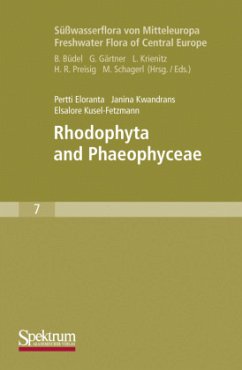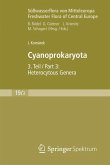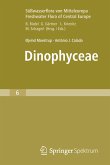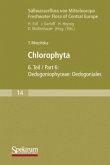Volume 7 of the series "Süßwasserflora/Freshwater Flora of Central Europe" covers the freshwater red algae and brown algae of this region. Freshwater red algae can be found in running waters, in lakes and ponds, on wet soils and sometimes also in hot sulphuric springs. The small group of freshwater brown algae occurs in rivers and lakes. Several freshwater red and brown algae are included into the red lists of threatened species.
Freshwater Rhodophyta is a rather small and systematically heterogeneous group. From a total number of about 200 freshwater red algal species, which were described, only one third is found in Europe representing nine orders and various life forms. Phaeophyceae, mainly found in the sea, cover a wide range of size from tiny thalli to huge marine kelps. In freshwaters, only seven species were described worldwide. All freshwater phaeophytes are small-sized, and appear as dark brown crusts or as tiny cushions on hard substrata. Some taxa can be found in clear and clean waters, others prefer brackish habitats.
Previous floras of Central European freshwater red and brown algae were published in this series by Pascher and Schiller in 1925, and by Starmach (1977) in the Flora Slodkowodna Polski [Fresh Water Flora of Poland]. Since then, no further identification keys were issued covering these groups of Central Europe. This book is intended to fill that gap and to aid both the algologists as well as applied researchers to efficiently and correctly identify European freshwater red and brown algae using updated nomenclature. Detailed descriptions of all taxa are given and high-quality drawings and photographs of the species facilitate their identification.
Freshwater Rhodophyta is a rather small and systematically heterogeneous group. From a total number of about 200 freshwater red algal species, which were described, only one third is found in Europe representing nine orders and various life forms. Phaeophyceae, mainly found in the sea, cover a wide range of size from tiny thalli to huge marine kelps. In freshwaters, only seven species were described worldwide. All freshwater phaeophytes are small-sized, and appear as dark brown crusts or as tiny cushions on hard substrata. Some taxa can be found in clear and clean waters, others prefer brackish habitats.
Previous floras of Central European freshwater red and brown algae were published in this series by Pascher and Schiller in 1925, and by Starmach (1977) in the Flora Slodkowodna Polski [Fresh Water Flora of Poland]. Since then, no further identification keys were issued covering these groups of Central Europe. This book is intended to fill that gap and to aid both the algologists as well as applied researchers to efficiently and correctly identify European freshwater red and brown algae using updated nomenclature. Detailed descriptions of all taxa are given and high-quality drawings and photographs of the species facilitate their identification.
Die Neubearbeitung vermittelt morphologisch, taxonomisch und nomenklatorisch den aktuellen Stand auf Spezialisten-Niveau, sie ist ein Standardwerk, das für voraussichtlich wieder lange Zeit die Grundlage und Referenz für Taxonomie, Nomenklatur und Identifikation der limnischen Rot- und Braunalgen sein wird und ist damit für die Algologen in Europa unverzichtbar. Lauterbornia 74, 29.06.2012 On the whole, this book is a useful tool for identifying European freshwater red and brown algae, supplemented with good quality graphics and light microscopical photographs. Besides it provides a very good summary about their life. It can be recommended in water quality monitoring, university education and to everyone investigating these interesting organisms. Acta Botanica Hungarica








